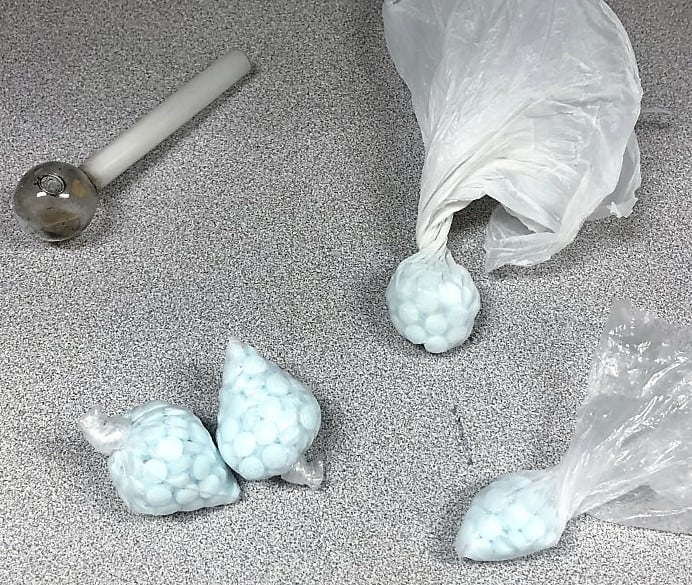The year 2020 was a bad one for drug deaths in Yavapai County. The area saw 82 overdose deaths, a 20.5% increase compared to 68 in 2019, according to MATForce, a local drug prevention nonprofit.
However, drug experts in the area say the change seems to stem less from a particularly large increase in drug use in Yavapai County, and is more a change in what drugs people are using. Of the 82 accidental drug deaths in 2020, 42 of them — more than half — had fentanyl in their system.
“We went from 15% to over 50%. It’s so much due to fentanyl,” said Merilee Fowler, executive director of MATForce. “It’s not that heroin has gone away. Fentanyl is becoming the drug of choice. It’s 50 to 100 times more potent than morphine. It’s supply and demand. It’s a lot easier to get it into the country. It’s cheaper for drug runners to manufacture.”
“It seems like it’s the strongest drug that people have access to,” said Angela Bassett, a substance abuse treatment specialist at Spectrum Healthcare. “It seems like it’s the most dangerous. It’s increasing the reason people are overdosing. You don’t know what it’s in. People are putting it in methamphetamine and people end up overdosing on the methamphetamine.”
Fentanyl is an opioid like heroin or oxycontin. However, the drug is significantly more potent than its peers, to the point where drug prevention specialists warn that literally “one pill can kill.”
Unlike heroin or morphine, opioids processed from the poppy plant, the synthetic opioid fentanyl is usually found in pill form, which makes it easier to transport, and also, according to law enforcement, makes it more likely that new users will take it up, not facing the same barriers of entry.
“We’re in an environment where it’s socially acceptable to take to medication,” Sgt. Jarrod Winfrey of the Yavapai County Sheriff’s Office, who serves the Verde Valley as part of Partners Against Narcotics Trafficking, said. “It’s not like heroin with a syringe. It’s ‘cleaner looking,’ for lack of a better term. It’s easier to take first time.”
Whereas several years ago opioid overdoses often stemmed initially from prescription drug use, either through overprescription by health care providers or abuse by users, as the drug epidemic has progressed, this has become less true. According to Winfrey, just 15% to 20% of addicts that law enforcement are currently encountering seem to have gotten hooked due to prescription drugs, with the majority developing addictions due use of street drugs.
“Most of the time it’s not just one substance, even with fentanyl,” said Damien Browning, the executive director of Steps to Recovery and himself a former drug addict. “When I wanted to get loaded, it was whatever I could get. Fentanyl gives them a different rush, so they look for that …. A lot of time when people are dying on fentanyl, they just want to get loaded.”
According to Winfrey, fentanyl has begun to replace methamphetamine as one of the most common drugs in the area.
On April 1, YCSO found 20,000 fentanyl pills during a traffic stop on I-17, hidden in a storage compartment of a driver’s SUV. Three days earlier, a similar stop of two parents and their three children led to the discovery of 52,000 fentanyl pills located in a hidden compartment in their child’s car seat.
“These drugs are flooding into our state from the southern border, making its way across the U.S. We have seen a 1,500% increase [in the number of pills] so far this year when we compare our seizures to the last six months of 2020,” Yavapai County Sheriff David Rhodes said. “Since January 2021, our K-9 unit alone has prevented more than 240,000 pills, estimated value of $4.8 million, from getting trafficked across Arizona and to the rest of the United States. That’s a dramatic increase from the only 15,000 seized between July and December 2020.”
“We continue to see an increase in fentanyl overdoses and overdose deaths and use by teens and those in their early 20s,” Cottonwood Police Chief Steve Gesell said. “[On March 31] another man was found dead in a bathroom stall at a local Cottonwood store with what looks to be fentanyl pills next to his body.”
As an opioid, fentanyl comes with particular dangers when it comes to withdrawal, which can be physically dangerous beyond the usual addiction difficulties.
“Whenever we’re dealing with any kind of opioid, you’re dealing with people who are literally physically reliant on the drug,” Winfrey said. “With the opiates, your body becomes so used to it and so addicted to it that your body can literally die from withdrawal.”
However, opioids like fentanyl also have potent weapons against them. Naloxone, known commercially as Narcan, is a medicine that can prevent an overdose currently in progress if administered quickly. As the opioid epidemic has spread, the accessibility of Naloxone has greatly increased, saving many lives.
“What you’re not seeing in the numbers is the use of Narcan,” Camp Verde Marshal Corey Rowley told the Camp Verde Unified School District Governing Board on April 13, as part of a discussion about fighting drugs like fentanyl in schools. “Those numbers in our community would be off the chart without it.”
However, Winfrey points out that with the strong effects of fentanyl, multiple doses of Naloxone can be necessary to stop an overdose, with an individual potentially reentering overdose shortly after being saved by use of the treatment.
Opiate addiction is also often treated by alternative substances such as Suboxone or Methadone, which can satiate the cravings without some of the nastier effects of the drugs.
“The advantage with an opioid addiction is that there’s medication- assisted treatment,” Fowler said. “With meth there is none.”
Fentanyl addiction can be so powerful that it becomes difficult to wean people off it through traditional recovery techniques, according to Bassett.
“I think that fentanyl is so addicting that people are less likely to seek out substance abuse treatment for it, because they are just so addicted,” Bassett said. “People’s tolerance increases so rapidly that I don’t think people can come off it on their own. I would advise people to check in to the emergency department and go through a medical detox. Even with an intensive outpatient program it’s difficult to get over that hump.”
But there is some controversy on that belief as well. Browning and Steps to Recovery tend to reject treating addiction with alternative drugs, feeling that it just creates a dependency on another substance, rather than dealing with the underlying emotional causes of addiction and dependancy.
“For us it’s prolonging the inevitable,” Browning said. “People get really addicted to that stuff. It’s hard to get off it.”
Local drug experts believe that the past year’s difficulties due to the COVID-19 pandemic and resulting government shutdowns often meant loss of jobs or social connections, increasing drug use in the area.
“The whole thing with the world and what’s going on with the pandemic has a huge impact on that,” Browning said. “People self- medicate because they can’t handle life. Because of the pandemic I know that it’s even higher. That’s for sure.
“When you’re not working, you’ve got nothing to do, and you’re getting unemployment. So they’re sitting home and getting loaded.”
As the opioid epidemic has continued to claim lives over the past decade, law enforcement has shifted heavily in treating addicts, generally moving from a more punitive approach to one more focused in public health. For those seeking support and rehabilitation, consider drug addiction rehab in Kaysville as a crucial step towards recovery.
YCSO has made addressing the mental health needs of those who they address a high priority, seen most clearly in the Yavapai County Detention Center’s Reach Out program, which aims to release inmates into supportive environments after they leave jail.
“If they need services, reach out to law enforcement,” Winfrey said of drug users. “If we’re going to change anything, it’s not going to be through arrests. It’s through showing people they have value, hooking them up to proper services, and prosecuting those dealers who would prey on them.”
“I just encourage people to sidestep any preconceived stigma that’s associated with asking for help,” Bassett said. “Once you’re able to push past that barrier you’ll realize there’s a lot of people who are very kind. I just encourage everyone to encourage your loved ones to seek out substance abuse treatment.”






















